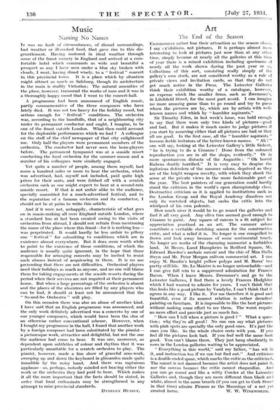Art
The End of the Season
Exruarrroxs rather lose their attraction as the season closes. I say (3e9ibitions, not pictures. It is perhaps almost more interesting to look at pictures just now than at any other time, simply because at nearly all the galleries at this time of year there is a mixed exhibition including specimens of nearly all the work shown during the past year or so, Collections of this sort, consisting really simply of the gallery's own stock, are not considered worthy as a rule of private views and invitation cards, so that they do not get much notice in the Press. The Leicester Galleries think their exhibition worthy of a catalogue, however, an expense which the smaller firms, such as Zwemmer's, in Litchfield Street, for the most part avoid. I can imagine no more amusing game than to go round and try to guess whom the pictures are by, which are by artists with well- known names and which by " humbler aspirants."
Sir Timothy Eden, in last week's issue, was bold enough to say that there were only two kinds of pictures—good and bad. But it makes it much easier to judge pictures if you start by assuming either that all pictures are bad or that all are good. In the first case, all the " humbler aspirants " become feeble imitators of the better-known names. " Ah ! " one will say, looking at the Leicester Gallery's little Sickert, " he is trying to do a Ckzanne ! Done from the coloured reproduction you see in all the shops, evidently." Or in more spontaneous distaste of the Augustin : " Oh horrid Rubens doubly horrified." It is very easy to despise the inglorious defenders of the summer salons, deprived as they are of the bright weapon novelty, with which they shock the sense at the private views in the more fashionable part of the year. The best painters of our generation could hardly stand the criticism in the world's open championship class. Destructive criticism as it is applied to institutions such as the London Group and the Royal Academy dissolves not only its wretched objects, but sucks the critic into the whirlpool of his own polemic.
How much nicer it would be to go round the galleries and find it all very good. Any olive tree seemed good enough to Cezanne to paint. Any square of canvas is a fit subject for appreciation practised as an art. The summer salons constitute a veritable sketching season for the constructive critic, and what a relief it is. No longer is one compelled to frown and look away because of some sentimental touch. No longer are works of the charming mannerist a forbidden land. At Messrs. Lund Humphries in Bedford Square, Mr. Edward Bawden's archaic naiveté and the chic of Miss Stella Steyn and Mr. Peter Morgan enliven commercial art. I can enjoy M. Baudin's bright yellow polyps and M. Bores' too pretty still life. Mr. Le Maistre is no longer untouchable—and I can give full rein to a suppressed admiration for Francis Bacon. When I leave Messrs. Zwemmer's and go to the Leicester Galleries, I find there a lovely Frances Hodgkins which I had wanted to admire for years. I can't think that this looks like a good picture by Vandyke, I can't think that it agrees in any way. I like it. For me therefore it is good and beautiful, even if its nearest relation is rather decadent painting on furniture. It is impossible to like the best pictures without making some effort to see them. The worst require no more effort and provide just as much fun.
" How can I tell when a picture is good ? " What a ques- tion ; why they're all good ! No one can say what pictures with pink spots are specially the only good ones. It's just the ones you like. So the whole choice rests with you. If you feel ill the pictures look bad. If you feel well the same look good. You can't blame them. They just hang obediently in rows in the London galleries waiting to be appreciated.
" Everything in this world," said my father, " has wit in it, and instruction too if we can but find out." And criticism is a double-ended spear, which marks the critic as the criticized.
The sunset is not damned because the artist does not paint it, nor the canvas because the critic cannot rhapsodize. And you can go round and like a witty Conder at the Leicester Galleries and, though they are more different than black and white, almost in the same breath (if you can get to Cork Street in that time) admire Picasso as the Munnings of a not yet


































 Previous page
Previous page